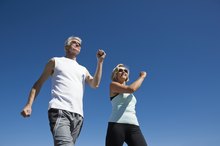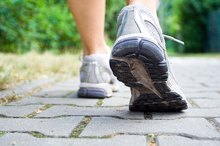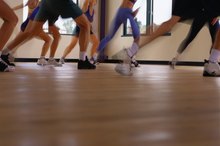What does fact checked mean?
At Healthfully, we strive to deliver objective content that is accurate and up-to-date. Our team periodically reviews articles in order to ensure content quality. The sources cited below consist of evidence from peer-reviewed journals, prominent medical organizations, academic associations, and government data.
- MedlinePlus: Exercise and Weight Loss
- MedlinePlus: Weight Management
- National Institutes of Health: Walking
- MayoClinic.com: Exercise for Weight Loss – Calories Burned in One Hour
- MayoClinic.Com: Walking for Fitness – How to Trim Your Waistline, Improve your Health
The information contained on this site is for informational purposes only, and should not be used as a substitute for the advice of a professional health care provider. Please check with the appropriate physician regarding health questions and concerns. Although we strive to deliver accurate and up-to-date information, no guarantee to that effect is made.
How Long Should a Person Walk to Burn Fat?
Your body stores unused calories as fat if you eat more food than your body uses for energy. Consuming a mere 100 calories a day more than you burn is enough to cause a weight gain of about 10 pounds in one year, according to MedlinePlus. Just 30 minutes of moderate exercise a day can help, and walking is a good way to start.
Body Fat
The recommended body fat percentage for women is 20 to 21 percent and for men it's 13 to 17 percent, according to MedLine Plus. The average body fat percentage in America for both groups is slightly higher than these numbers. Extra body fat, especially around your middle, puts you at risk for diseases such as high blood pressure, diabetes and heart disease.
Calories and Fat
Does Walking Help You Lose the Fat Around Your Waist?
Learn More
One pound of fat is equal to about 3,500 unused calories, according to the National Institutes of Health. How much fat you lose during walking depends on a few variables, such as how much you weigh, how many calories you consume each day and the intensity of your exercise. In general, an adult has to walk at least 30 miles to burn one pound of fat, or 3,500 calories. Fortunately, you can spread those 30 miles over days, weeks or a month and achieve the same fat loss -- if your caloric intake remains constant.
- One pound of fat is equal to about 3,500 unused calories, according to the National Institutes of Health.
- In general, an adult has to walk at least 30 miles to burn one pound of fat, or 3,500 calories.
Aerobic Walking
Walking is an aerobic exercise, which means it uses major muscle groups to perform a continuous physical activity for a sustained period of time. During aerobic exercise you move your legs, arms, hips and waist for a sustained period to increase your heart rate and deepen your breathing. The benefits of aerobic exercise are increased with interval training, which combines regular brisk walking with bursts of faster walking. Interval training burns more calories and improves your cardiovascular strength.
- Walking is an aerobic exercise, which means it uses major muscle groups to perform a continuous physical activity for a sustained period of time.
- The benefits of aerobic exercise are increased with interval training, which combines regular brisk walking with bursts of faster walking.
Walking Speed and Duration
Does Jogging Reduce Thigh Size?
Learn More
During a 2-mile-per-hour walk lasting one hour, a 160-pound person burns 183 calories, a 200-pound person burns 228 calories and a 240-pound person burns 273 calories, according to the National Institutes of Health. During a 3.5-mph walk lasting one hour, a 160-pound person burns 277 calories, a 200-pound person burns 346 calories and a 240-pound person burns 414 calories. NIH recommends starting gradually, such as walking three days a week, and building to faster and longer walks over a few weeks.
- During a 2-mile-per-hour walk lasting one hour, a 160-pound person burns 183 calories, a 200-pound person burns 228 calories and a 240-pound person burns 273 calories, according to the National Institutes of Health.
- During a 3.5-mph walk lasting one hour, a 160-pound person burns 277 calories, a 200-pound person burns 346 calories and a 240-pound person burns 414 calories.
Form
Moving all of your body parts helps elevate your walk to the level of an aerobic activity. Swing your arms in a natural motion while walking, and walk by placing your heel on the ground first and rolling your weight forward onto your feet. Maintain an upright posture by keeping your chin raised, your shoulders back and your toes pointed forward.
Tips
Wear comfortable shoes and loose-fitting clothing while you walk. MayoClinic.com recommends that you warm up before your walk with slow walking, followed by stretching all of your muscles 2. End your walk with a 5-minute cool-down period, followed by more stretching.
Warnings
See your doctor before beginning an exercise program, especially if you have a medical condition. Choose a safe walking location, wear reflective tape and avoid distractions, such as earphones, that can results in accidents.
Related Articles
References
- MayoClinic.com: Exercise for Weight Loss – Calories Burned in One Hour
- MayoClinic.Com: Walking for Fitness – How to Trim Your Waistline, Improve your Health
- Bairapareddy KC, Maiya AG, Kumar P, Nayak K, Guddattu V, Nayak V. Effect of aerobic exercise on echocardiographic epicardial adipose tissue thickness in overweight individuals. Diabetes Metab Syndr Obes. 2018;11:303-312. doi:10.2147/DMSO.S145862
- Schwarz M, Urhausen A, Schwarz L, Meyer T, Kindermann W. Cardiocirculatory and metabolic responses at different walking intensities. Br J Sports Med. 2006;40(1):64-7. doi:10.1136/bjsm.2005.020198
- Karstoft K, Winding K, Knudsen SH, et al. The effects of free-living interval-walking training on glycemic control, body composition, and physical fitness in type 2 diabetic patients: a randomized, controlled trial. Diabetes Care. 2013;36(2):228-36. doi:10.2337/dc12-0658
- Haight DJ, Lerner ZF, Board WJ, Browning RC. A comparison of slow, uphill and fast, level walking on lower extremity biomechanics and tibiofemoral joint loading in obese and nonobese adults. J Orthop Res. 2014;32(2):324-30. doi:https://doi.org/10.1002/jor.22497
- Hong HR, Jeong JO, Kong JY, et al. Effect of walking exercise on abdominal fat, insulin resistance and serum cytokines in obese women. J Exerc Nutrition Biochem. 2014;18(3):277-85. doi:10.5717/jenb.2014.18.3.277
Writer Bio
Gail Sessoms, a grant writer and nonprofit consultant, writes about nonprofit, small business and personal finance issues. She volunteers as a court-appointed child advocate, has a background in social services and writes about issues important to families. Sessoms holds a Bachelor of Arts degree in liberal studies.









